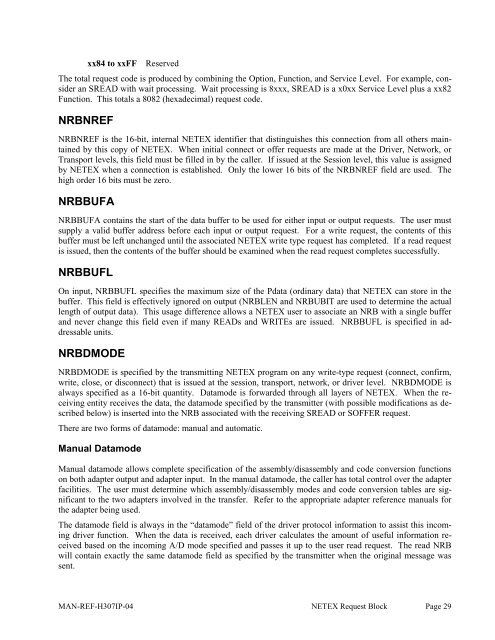SDISC Assembler Call - NetEx
SDISC Assembler Call - NetEx
SDISC Assembler Call - NetEx
- No tags were found...
You also want an ePaper? Increase the reach of your titles
YUMPU automatically turns print PDFs into web optimized ePapers that Google loves.
xx84 to xxFF ReservedThe total request code is produced by combining the Option, Function, and Service Level. For example, consideran SREAD with wait processing. Wait processing is 8xxx, SREAD is a x0xx Service Level plus a xx82Function. This totals a 8082 (hexadecimal) request code.NRBNREFNRBNREF is the 16-bit, internal NETEX identifier that distinguishes this connection from all others maintainedby this copy of NETEX. When initial connect or offer requests are made at the Driver, Network, orTransport levels, this field must be filled in by the caller. If issued at the Session level, this value is assignedby NETEX when a connection is established. Only the lower 16 bits of the NRBNREF field are used. Thehigh order 16 bits must be zero.NRBBUFANRBBUFA contains the start of the data buffer to be used for either input or output requests. The user mustsupply a valid buffer address before each input or output request. For a write request, the contents of thisbuffer must be left unchanged until the associated NETEX write type request has completed. If a read requestis issued, then the contents of the buffer should be examined when the read request completes successfully.NRBBUFLOn input, NRBBUFL specifies the maximum size of the Pdata (ordinary data) that NETEX can store in thebuffer. This field is effectively ignored on output (NRBLEN and NRBUBIT are used to determine the actuallength of output data). This usage difference allows a NETEX user to associate an NRB with a single bufferand never change this field even if many READs and WRITEs are issued. NRBBUFL is specified in addressableunits.NRBDMODENRBDMODE is specified by the transmitting NETEX program on any write-type request (connect, confirm,write, close, or disconnect) that is issued at the session, transport, network, or driver level. NRBDMODE isalways specified as a 16-bit quantity. Datamode is forwarded through all layers of NETEX. When the receivingentity receives the data, the datamode specified by the transmitter (with possible modifications as describedbelow) is inserted into the NRB associated with the receiving SREAD or SOFFER request.There are two forms of datamode: manual and automatic.Manual DatamodeManual datamode allows complete specification of the assembly/disassembly and code conversion functionson both adapter output and adapter input. In the manual datamode, the caller has total control over the adapterfacilities. The user must determine which assembly/disassembly modes and code conversion tables are significantto the two adapters involved in the transfer. Refer to the appropriate adapter reference manuals forthe adapter being used.The datamode field is always in the “datamode” field of the driver protocol information to assist this incomingdriver function. When the data is received, each driver calculates the amount of useful information receivedbased on the incoming A/D mode specified and passes it up to the user read request. The read NRBwill contain exactly the same datamode field as specified by the transmitter when the original message wassent.MAN-REF-H307IP-04 NETEX Request Block Page 29















